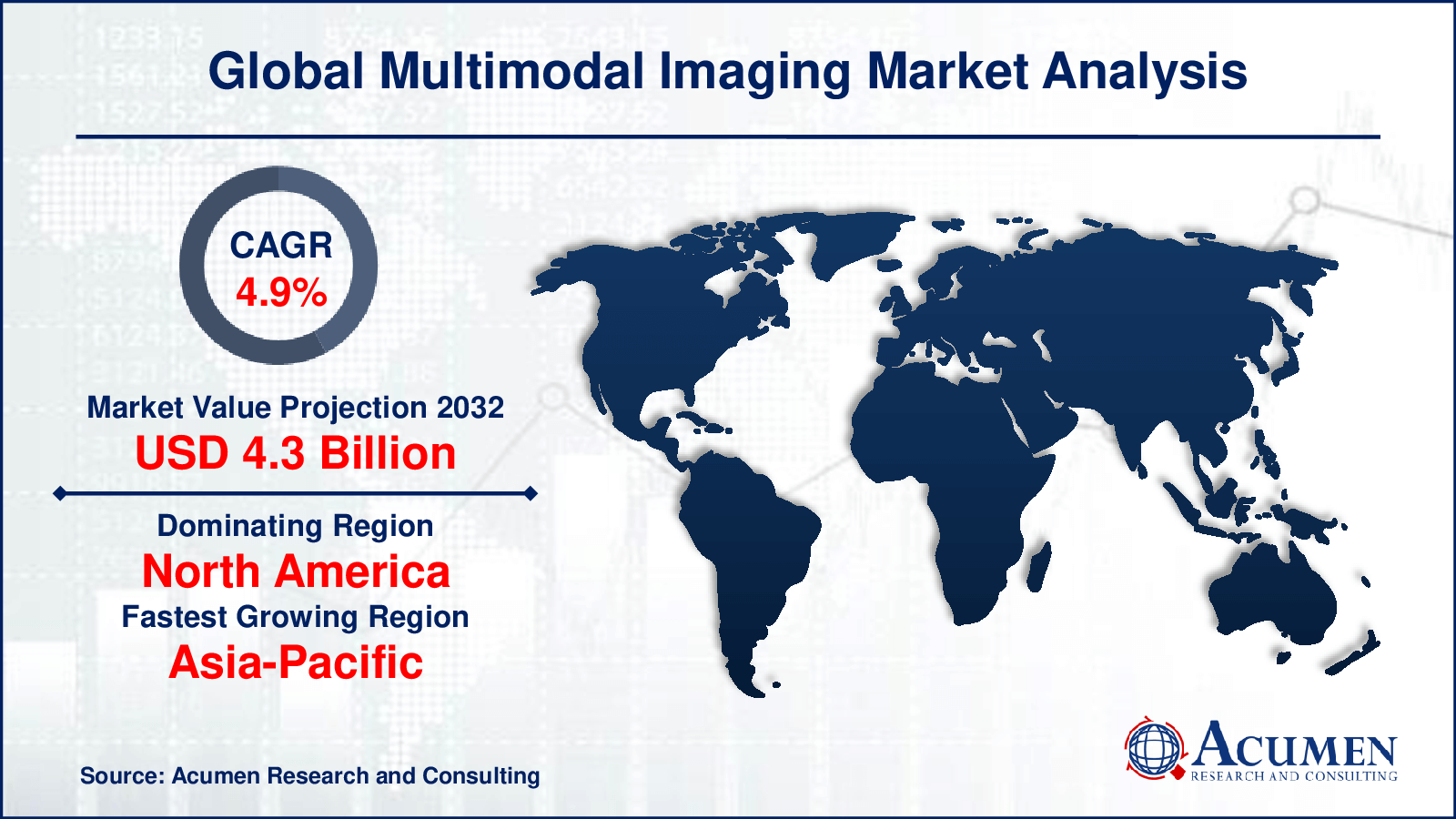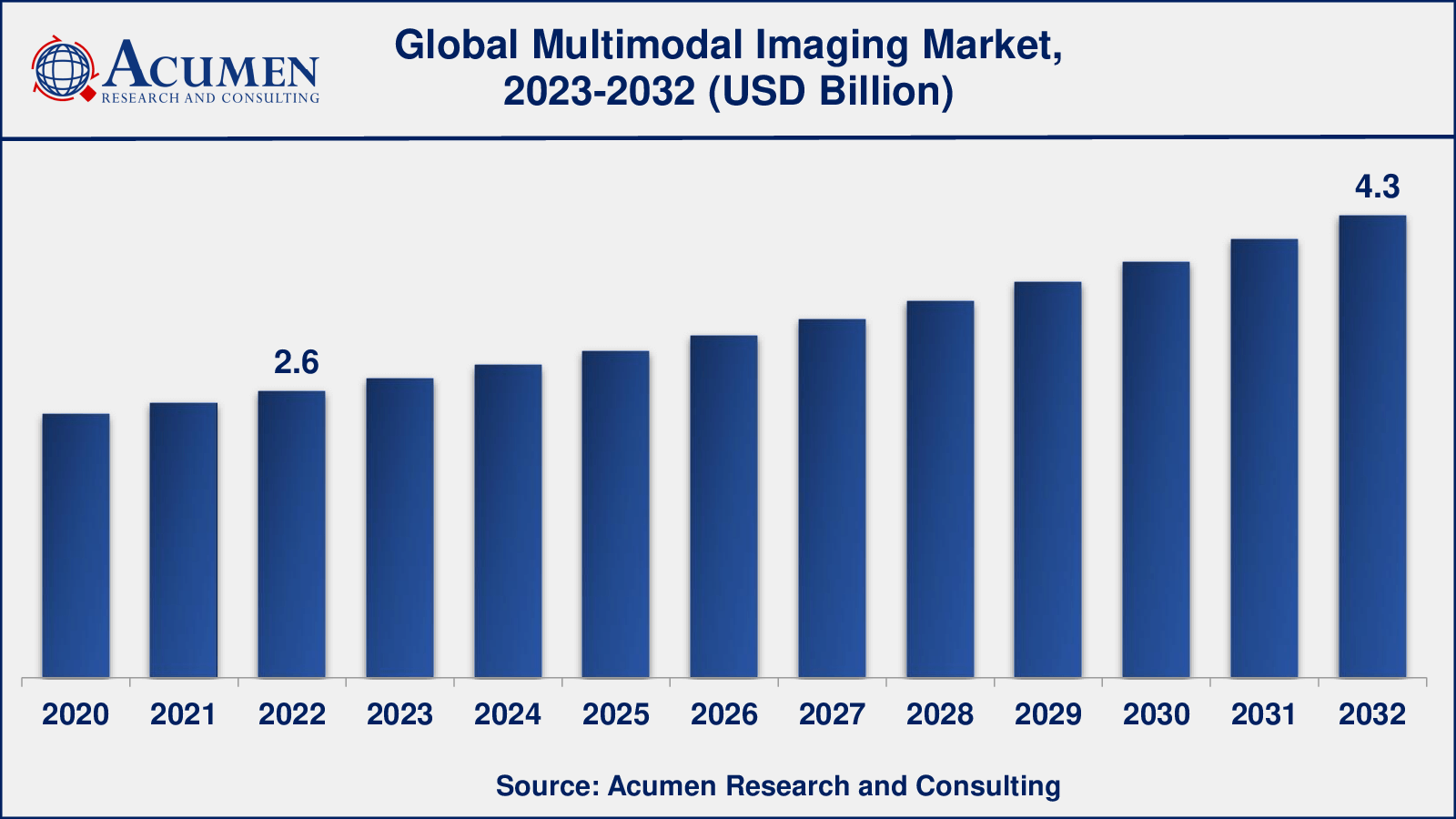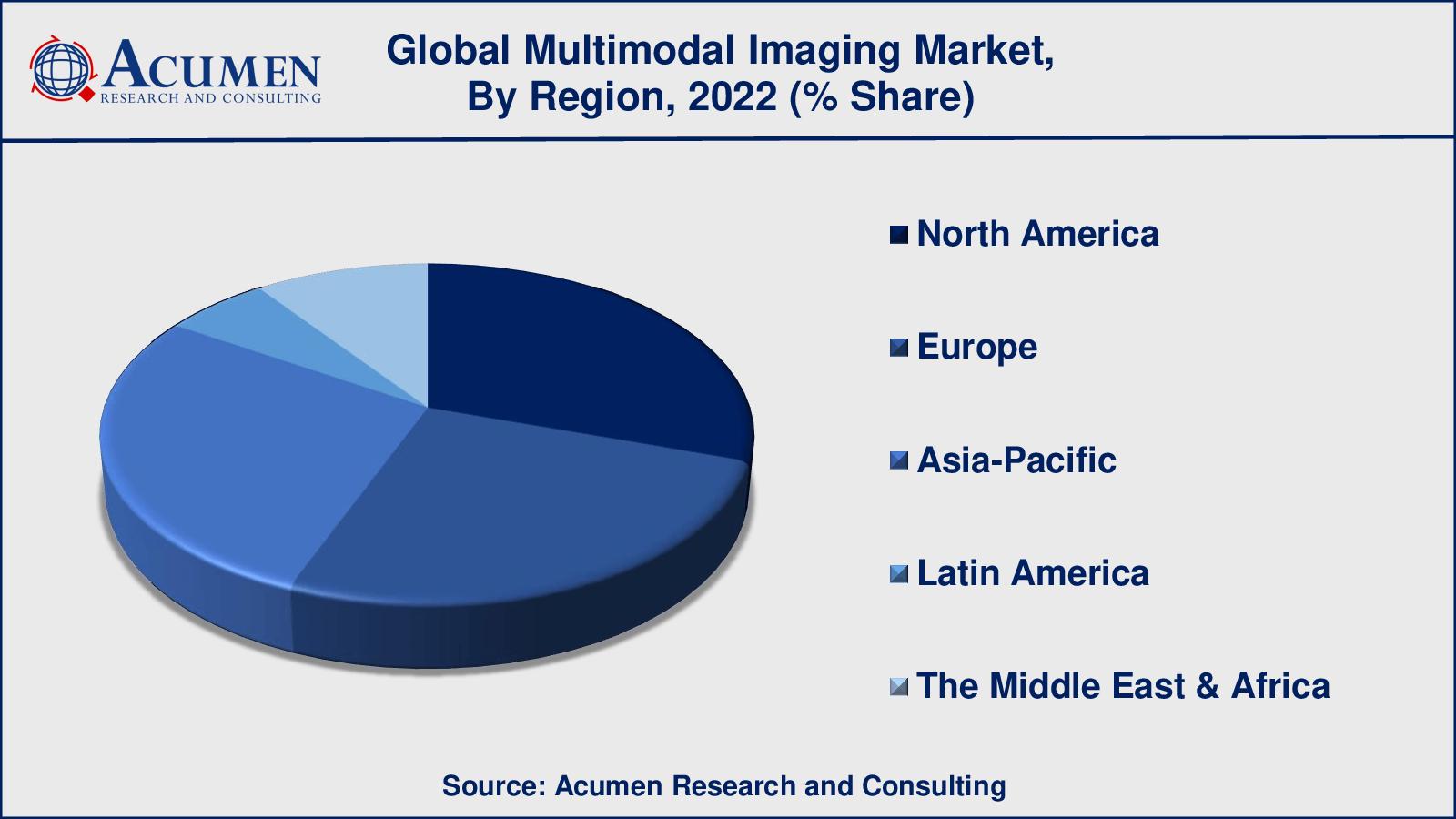Multimodal Imaging Market | Acumen Research and Consulting
Multimodal Imaging Market Size - Global Industry, Share, Analysis, Trends and Forecast 2023 - 2032
Published :
Report ID:
Pages :
Format :
The Global Multimodal Imaging Market Size accounted for USD 2.6 Billion in 2022 and is estimated to achieve a market size of USD 4.3 Billion by 2032 growing at a CAGR of 4.9% from 2023 to 2032.
Multimodal Imaging Market Highlights
- Global multi-modal imaging market revenue is poised to garner USD 4.3 billion by 2032 with a CAGR of 4.9% from 2023 to 2032
- North America multimodal imaging market value occupied around 792 million in 2022
- Asia-Pacific multimodal imaging market growth will record a CAGR of more than 5% from 2023 to 2032
- Among product, the multimodal imaging equipment sub-segment generated over US$ 1.1 billion revenue in 2022
- Based on end-user, the hospitals sub-segment generated around 45% share in 2022
- Integration with AI and machine learning is a popular market trend that fuels the industry demand

Multimodal imaging is the utilization of numerous imaging techniques or modalities to provide complementary and comprehensive information about a certain subject or area of interest. Medical imaging modalities include positron emission tomography (PET), magnetic resonance imaging (MRI), computed tomography (CT), single-photon emission computed tomography (SPECT), ultrasound, and optical imaging.
The primary goal for multimodal imaging is to combine the capabilities of several imaging methods in order to overcome their individual limitations. Each imaging technique has distinct benefits and delivers unique information about the topic under inquiry. MRI, for example, is very good at visualizing soft tissues and provides comprehensive anatomical information, but PET and SPECT may identify functional and molecular alterations at the cellular level. Researchers and physicians can gain a more complete and accurate understanding of the underlying structures, functions, and processes in a specific region by integrating different modalities.
Multimodal imaging is often employed in a variety of medical specialties, including clinical applications, cancer, cardiology, and orthopedics. It has also found use in preclinical research, allowing for the study of disease models and the development of novel treatment methods. As imaging technology advances, the integration of several modalities becomes more sophisticated, allowing for more accurate and detailed imaging of complicated biological processes.

Global Multimodal Imaging Market Dynamics
Market Drivers
- Advancements in imaging technologies
- Rising prevalence of chronic diseases
- Focus on personalized medicine
- Government initiatives, and technological integration
Market Restraints
- High costs of multimodal imaging
- Limited availability of skilled professionals
- Regulatory challenges
Market Opportunities
- Emerging applications in research and drug development
- Expansion in emerging markets
- Technological innovations and collaborations/partnerships
Multimodal Imaging Market Report Coverage
| Market | Multimodal Imaging Market |
| Multimodal Imaging Market Size 2022 | USD 2.6 Billion |
| Multimodal Imaging Market Forecast 2032 | USD 4.3 Billion |
| Multimodal Imaging Market CAGR During 2023 - 2032 | 4.9% |
| Multimodal Imaging Market Analysis Period | 2020 - 2032 |
| Multimodal Imaging Market Base Year | 2022 |
| Multimodal Imaging Market Forecast Data | 2023 - 2032 |
| Segments Covered | By Technology, By Product, By Application, By End-User, And By Geography |
| Regional Scope | North America, Europe, Asia Pacific, Latin America, and Middle East & Africa |
| Key Companies Profiled | Canon Inc., GE Healthcare, Koninklijke Philips N.V., Infraredx Inc., Mediso Medical Imaging Systems Kft, Neusoft Medical Systems Co. Ltd., Siemens Healthineers, Spectrum Dynamics Medical, Topcon Corporation, and United Imaging Healthcare Co. Ltd. |
| Report Coverage |
Market Trends, Drivers, Restraints, Competitive Analysis, Player Profiling, Covid-19 Analysis, Regulation Analysis |
Multimodal Imaging Market Insights
The multimodal imaging market is driven by several key factors. For starters, advances in imaging technology have considerably aided market expansion. Continuous advances in resolution, acquisition speed, and sensitivity have improved the accuracy and detail of multimodal imaging, resulting in better diagnostic capabilities and treatment planning.
Second, the increasing frequency of chronic illnesses has resulted in an increase in the need for multimodal imaging. Comprehensive examinations are required for accurate diagnosis and successful treatment of conditions such as cancer, cardiovascular illnesses, and neurological ailments. Multimodal imaging provides a comprehensive picture of disease development, allowing for early identification, precise diagnosis, and therapy efficacy monitoring.
Third, there is a rising emphasis on personalized medicine, which involves tailoring therapies to particular patients. Multimodal imaging is critical in this technique since it provides full information about a patient's condition. It enables personalized treatment regimens and targeted medicines based on unique traits and treatment responses.
Government efforts and financing are also important drivers of the multimodal imaging industry. Through financing programmes and favorable reimbursement rules, several governments are actively encouraging the development and implementation of new imaging technology. These measures encourage healthcare providers to invest in multimodal imaging equipment, which in turn drives market growth.
However, there are several constraints in the multimodal imaging business. The high costs of multimodal imaging systems, equipment, maintenance, and image processing software might be an impediment to adoption, especially for smaller healthcare institutions or regions with low resources. Furthermore, manufacturers face obstacles as a result of tight regulatory regulations and clearance processes, possibly delaying product releases and raising total costs.
In addition, the availability of qualified specialists is an important aspect in the effective application of multimodal imaging. The technique necessitates the use of skilled persons capable of operating and interpreting complicated imaging devices. The scarcity of trained individuals in the sector may impede the general adoption and successful use of multimodal imaging.
Despite these obstacles, the multimodal imaging sector offers several potential. Multimodal imaging is being used in new applications in research and drug development, particularly in preclinical investigations, to study disease models, evaluate medication effectiveness, and investigate therapeutic treatments. Integrating multimodal imaging with artificial intelligence (AI) and machine learning algorithms has the potential to improve picture interpretation, automated abnormality identification, and predictive modeling.
The expansion of the multimodal imaging industry into emerging areas such as Asia-Pacific and Latin America provides considerable potential prospects. Increasing healthcare infrastructure, rising disposable incomes, and increased knowledge of innovative diagnostic procedures all contribute to market growth in these regions.
Technological advancements propel market expansion by offering innovative multimodal imaging technologies with increased sensitivity, greater resolution, and real-time imaging capabilities. These developments improve diagnostic skills and broaden the spectrum of clinical uses.
Finally, alliances and partnerships among imaging equipment makers, pharmaceutical firms, and research institutes can help to accelerate the development of integrated multimodal imaging systems. Strategic collaborations capitalize on the knowledge of many stakeholders, accelerating the use of multimodal imaging in clinical practice and driving market growth.
Multi-Modal Imaging Market Segmentation
The worldwide market for multimodal imaging is split based on technology, product, application, end-user, and geography.
Multi-Modal Imaging Technologies
- PET/CT
- SPECT/CT
- PET/MR
- OCT/Fundus Imaging
- Others
According to multimodal imaging industry analysis, PET/CT has dominated the multimodal imaging market. PET/CT combines the functional imaging capabilities of PET with the anatomical imaging capabilities of computed tomography (CT). This combination enables the capture of metabolic and structural information at the same time, allowing for a full assessment of many illnesses and disorders.
PET/CT scanning has become widely used in oncology, notably for cancer diagnosis, staging, and therapy planning. It allows for the visualisation of metabolic activity in tissues, which aids in tumour diagnosis and characterisation. The incorporation of CT aids in accurately locating metabolic anomalies within the anatomical context, enhancing tumour identification and localisation accuracy.
Another multimodal imaging approach is SPECT/CT, which combines single-photon emission computed tomography (SPECT) with computed tomography (CT). PET/CT has eclipsed SPECT/CT in terms of commercial domination, despite finding major uses in nuclear medicine. PET/CT has higher sensitivity, better picture quality, and a wider range of radiotracers available, making it the preferable choice in many clinical scenarios.
PET/MR is a relatively recent multimodal imaging method that combines PET's metabolic imaging with magnetic resonance imaging's rich anatomical and functional information. Although PET/MR has shown potential in some areas, such as neurology and cancer, it is still regarded as a niche technology with little market penetration when compared to PET/CT.
Multi-Modal Imaging Products
- Multimodal Imaging Equipment
- Reagents
- Software
The worldwide multimodal imaging market is led by multimodal imaging equipment. Multimodal imaging equipment refers to specialised imaging systems and devices designed to collect data from numerous imaging modalities at the same time or sequentially. These systems combine imaging methods such as PET/CT, SPECT/CT, PET/MRI, and others to offer complete and complementary information on the issue under research.
The backbone of multimodal imaging processes is multimodal imaging equipment, which is required for gathering and creating multimodal pictures or datasets. These equipment systems are intended to assure perfect spatial and temporal alignment of pictures obtained from various modalities, allowing for accurate data fusion and integration. They are essential in a variety of applications, including clinical diagnosis, research, and drug development.
While reagents and software are significant components of the multimodal imaging ecosystem, they do not have market dominance. In multimodal imaging, reagents are utilised to label and designate particular targets for imaging, increasing the sensitivity and specificity of the imaging approaches. In contrast, software supports image processing, analysis, fusion, and visualisation of multimodal data collected via imaging equipment. Both reagents and software are essential for the efficient deployment and interpretation of multimodal imaging, but the multimodal imaging equipment itself dominates the market.
Multi-Modal Imaging Applications
- Clinical Applications
- Oncology
- Cardiology
- Neurology
- Orthopedics
- Others
The bulk of the multimodal imaging market was dominated by oncology. Oncology actively use multimodal imaging for several areas of cancer care, including diagnosis, staging, therapy planning, and treatment response monitoring. PET/CT and PET/MR multimodal imaging methods have become essential in cancer, allowing for the visualisation of metabolic activity, tumour localisation, and disease extent evaluation within the anatomical context.
Multimodal imaging is important in oncology because it provides detailed information about the tumor's properties, such as size, location, and metabolic activity. This aids in appropriate staging, therapy selection, and therapeutic intervention monitoring. The ability to integrate functional and structural data enables doctors to accurately determine tumour borders, evaluate therapy response, and detect metastases or recurrence.
In addition to these well-known uses, multimodal imaging has been studied and utilised in a variety of other fields, including gastroenterology, pulmonology, urology, and paediatrics. While these applications contribute to the overall multimodal imaging market, oncology continues to be the key driver and accounts for the bulk of the industry share due to the high demand and widespread usage of multimodal imaging methods in cancer care.
Multi-Modal Imaging End-Users
- Hospitals
- Diagnostic Centers
- Others

According to the multimodal imaging market forecast, Hospitals dominated the multimodal imaging market among the listed end-users. Hospitals are the principal healthcare facilities that rely heavily on multimodal imaging technology for a variety of diagnostic and therapeutic objectives. To serve a wide range of medical specialisations and patient demographics, these institutions often feature dedicated imaging departments outfitted with modern multimodal imaging technologies.
While hospitals continue to lead the multimodal imaging industry, other end-users are also contributing to its expansion. Diagnostic centres that specialise in imaging services also play an important role. These facilities are primarily concerned with diagnostic imaging and frequently offer multimodal imaging services to individuals recommended by physicians or healthcare professionals.
Academic and research institutes are also key multimodal imaging end users. These institutes do cutting-edge research, conduct clinical studies, and create novel imaging techniques. They use multimodal imaging for both preclinical and clinical investigations, leading to field improvements and increasing multimodal imaging applications.
Multi-Modal Imaging Market Regional Outlook
North America
- U.S.
- Canada
Europe
- U.K.
- Germany
- France
- Spain
- Rest of Europe
Asia-Pacific
- India
- Japan
- China
- Australia
- South Korea
- Rest of Asia-Pacific
Latin America
- Brazil
- Mexico
- Rest of Latin America
The Middle East & Africa
- South Africa
- GCC Countries
- Rest of the Middle East & Africa (ME&A)

Multimodal Imaging Market Regional Analysis
North America has a sizable part of the multimodal imaging industry. The region's robust healthcare infrastructure, cutting-edge research capabilities, and favorable reimbursement regulations all contribute to market expansion. The existence of important market participants, technical improvements, and high healthcare spending all contribute to the region's adoption of multimodal imaging technology.
Europe is another important multimodal imaging market. The region features major academic and research institutes, as well as a strong emphasis on sophisticated medical technology. The availability of favorable reimbursement policies and government efforts supporting R&D activities drive the growth of the European multimodal imaging industry.
The Asia-Pacific region's multimodal imaging industry is rapidly expanding. Increasing healthcare investments, increasing medical tourism, and better healthcare infrastructure all help to drive market growth. The region has a huge patient population and an increasing prevalence of chronic illnesses, which drives need for improved diagnostic imaging technology. Furthermore, continuous healthcare innovations and increased acceptance of multimodal imaging methods in countries like as China, India, and Japan contribute to market growth in this region.
Multimodal Imaging Market Players
Some of the top multimodal imaging companies offered in our report includes Canon Inc., GE Healthcare, Koninklijke Philips N.V., Infraredx Inc., Mediso Medical Imaging Systems Kft, Neusoft Medical Systems Co. Ltd., Siemens Healthineers, Spectrum Dynamics Medical, Topcon Corporation, and United Imaging Healthcare Co. Ltd.
Philips has been a driving force in the advancement of multimodal imaging technology. The business made a huge advancement by introducing the Vereos PET/CT, the world's first digital PET/CT system. This system uses digital silicon photomultiplier detector technology to increase picture resolution, sensitivity, and quantitative accuracy. Clinicians can use the Vereos PET/CT to detect tiny lesions, generate sharper pictures, and boost diagnostic confidence.
Siemens Healthineers is well-known in the multimodal imaging sector for its contributions. The Biograph Vision Quadra, a positron emission tomography/computed tomography (PET/CT) system with Time-of-Flight (TOF) technology, was recently introduced by the business. This technology provides increased picture quality, shorter scan durations, and more diagnostic accuracy. The Biograph Vision Quadra is intended to serve a wide range of clinical applications, including cancer, neurology, and cardiology, by enabling accurate illness diagnosis and treatment planning.
Frequently Asked Questions
What was the market size of the global multimodal imaging in 2022?
The market size of multimodal imaging was USD 2.6 billion in 2022.
What is the CAGR of the global multimodal imaging market from 2023 to 2032?
The CAGR of multimodal imaging is 4.9% during the analysis period of 2023 to 2032.
Which are the key players in the multimodal imaging market?
The key players operating in the global market are including Canon Inc., GE Healthcare, Koninklijke Philips N.V., Infraredx Inc., Mediso Medical Imaging Systems Kft, Neusoft Medical Systems Co. Ltd., Siemens Healthineers, Spectrum Dynamics Medical, Topcon Corporation, and United Imaging Healthcare Co. Ltd.
Which region dominated the global multimodal imaging market share?
North America held the dominating position in multimodal imaging industry during the analysis period of 2023 to 2032.
Which region registered fastest CAGR from 2023 to 2032?
Asia-Pacific region exhibited fastest growing CAGR for market of multimodal imaging during the analysis period of 2023 to 2032.
What are the current trends and dynamics in the global multimodal imaging industry?
The current trends and dynamics in the multimodal imaging industry include advancements in imaging technologies, rising prevalence of chronic diseases, and focus on personalized medicine.
Which application held the maximum share in 2022?
The PET/CT application held the maximum share of the multimodal imaging industry.?



